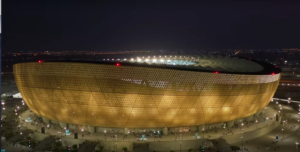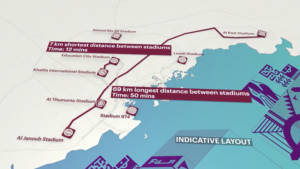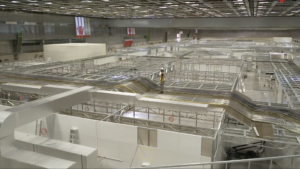2022 FIFA World Cup Preview: Fox Sports Embraces Home Run Production
Production execs David Neal and Kevin Callahan discuss plans and expectations
This article originally appeared in the Fall 2022 Edition of the SVG SportsTech Journal. To read the entire journal, click HERE.
Beginning on Nov. 20, the most popular global sports event will kick off in Qatar: the 2022 FIFA World Cup. For the team at Fox Sports, the 2022 edition provides an opportunity to finally showcase the U.S. men’s team, which didn’t qualify for the 2018 FIFA World Cup in Russia. And it will allow Fox Sports to showcase new technologies that embrace Home Run Production, bonded cellular, and IP in ways that not only make things easier but increase the content output. At the SVG Remote Production Forum in Los Angeles, SVG sat down with David Neal, executive producer, FIFA World Cup on Fox/ VP, production, and Kevin Callahan, VP, field operations and Engineering, to discuss the broadcaster’s plans and what to expect.

Stadiums for the 2022 FIFA World Cup in Doha have full fiber connectivity to maximize signal distribution internally and externally.
What are your expectations heading into the 2022 FIFA World Cup?
Neal: One thing on our mind every day is that the U.S. is in this World Cup, as opposed to four years ago when they weren’t. When you’re put in an adverse situation, sometimes your best work comes out of it. I was exceedingly proud of what we put on the air from Russia, but it was an inescapable fact that the U.S. wasn’t there. And the collateral damage that did to our viewership numbers was unmistakable.
This time around, the buzz going into the tournament is [the U.S. team] not only qualified but actually is good. I mean, this is a young team with some genuine stars who are playing on an international level. It gives a lot of anticipation to what we’re doing. You can’t go a day reading soccer media without seeing some mention of the the U.S. vs. England game on Black Friday, the day after Thanksgiving. That by itself, especially if the U.S. wins its first group game — which they should do against Wales — has the potential to be one of the five most-watched soccer games in U.S. television history. And that’s just for a Group Stage match. For us, the game-changer is the fact that the U.S. is gonna be there. We’re bringing more people to Qatar because, first, the U.S. is there and, second, because of the compact nature [of the tournament]: the eight stadiums are no farther than 90 minutes apart.
What does that compact footprint mean?
Neal: Instead of having talent and production crews crisscrossing a country like we did in Russia — sometimes changing planes at 2:00 a.m. trying to get to Sochi for a noon kickoff — we’ll have everybody staying in the same hotel. Nobody has to get on an airplane from the time they arrive until the time they leave. Because of that, when our bosses were going through the budget, they said, “Let’s just go all-in.” This will be the first time ever that a U.S. rightsholder called all the matches with a commentary team in the stadium. With the exception of some significant back-of-house operations, we’re taking everything to Qatar, which is a throwback to how things used to be.
Do you plan to have more ENG crews?
Callahan: We will have more crews this time around, and they’ll be doing different things. We have more reporters in-country because we’re able to get a lot more content out of them. We also have two crews that are dedicated to capturing the news of the day and flavor of the country, shooting things like a new scenic every day. One of our post-mortem comments from Russia was, we used the same bumper shot of birds every day. We want to make sure we’re showing off everything that Qatar is.
What is the RF situation for ENG crews?
Callahan: The RF situation’s actually interesting. It is nearly clear spectrum-wise, which is very different from what we’re used to. That is mainly because there isn’t a lot of terrestrial TV distribution. But we tend to shy away from RF in venues when we are overseas.
We are relying heavily on bonded cellular, and all of our ENG teams and digital teams will have LiveU backpacks. We are also using them for the affiliates so they can provide content 24 hours a day when the national network is off-air.
Can you tell us about the plans regarding a studio show and set?
Neal: It’s different because there’s nothing in Qatar that is instantly recognizable to an American audience. We are on a set that basically looks like all of our previous sets but on steroids. We’re creating a destination, and we’re going to be located next to the fanfest; we want to tap into the energy there. It gives us a great view of the ultra-modern skyline, and it goes back to everything being centralized as all the fans will be staying somewhere in the area.
We will also have a practice pitch, but the field is actually just a giant LED screen. To the viewer, it will look like a grass field. There’s a lot of technology that our brilliant Creative Director Gary Hartley employed in the A Stage on the Fox lot, and you’ll see a lot of that same big technology on this set.
This World Cup is much like an Olympics, given the small footprint. Did you draw on any skills you developed while at NBC Olympics?
Neal: Yes, and there’s no doubt that we can focus more on bringing the country to life because we know the stadiums are easily accessible. Our operations are manageable because the stadiums are so close to one another. There are the 32 teams, and those are sort of your actors: there is an antagonist and a protagonist, hero and villain. But one thing I learned at NBC Olympics is, there is a 33rd character and that is the host country. We brought Russia to life four years ago, we brought France to life three years ago, and that’s what we’ll do with Qatar.

The eight World Cup stadiums are within an hour’s drive of each other.
Let’s walk through the evolution of the IBC. What will the operations look like?
Callahan: They’ll be similar in size and scope to the Women’s World Cup operations, where we pivoted and essentially removed production and studio production from the IBC. We will have studio production at the studio location, and the IBC will be where all the feeds — 80+ feeds from HBS, including 40 per match — come in and we monitor them.
The key at the IBC is just being able to monitor and see everything that is coming in and going out. It’s the hub that connects to the studio location and all the venues, as well as our L.A. facility and now our Tempe, AZ, facility. There will be roughly 50 people there, and the heart is the remote-operations center, which is the TOC. And we have a backup studio.
We essentially have nine venues that we’re looking at, and we treat all of those as a small remote production. We have a kit that goes into a cabin; we’ve done all of our World Cups that way. The venues are a remote into the IBC or remote back into Los Angeles. It doesn’t make sense to put a dedicated mobile unit in a venue to put the clock and score and do an announcer mix. We will do that at the IBC because, in November and December, the Pico facility [in Los Angeles] will be busy with college football and basketball and the NFL.
Our postproduction team and editors for all of the features will be back in the U.S., and that’s something we’ve done since 2015. We want to give them access to all that great content that our ENG shooters are shooting and that FIFA and HBS are producing.
What preparation did you do with regard to facilities in the IBC?
Callahan: This summer, we worked with TAG Video Systems to set up our IBC and studio facility outside our Charlotte location for about a month. Then, we just packed it up and put it in an aircraft to head over to Qatar. We purpose-built the flypacks, and we will be doing that for our Jewel events, like the World Cups, Super Bowl, and now the Euros and other events.
TAG Video Systems is our multiviewer and monitoring system to see everything in the ST 2110 IP world, the SDI world, and then JPEG-XS, which is our transmission format. The level of integration between all the different aspects between audio, video, and the traditional workflows have been kind of thrown out the window here, and it’s exciting to be part of something that is very cutting edge.
Why is it important to be able to fly it over vs. a boat, which is how a lot of these shows have been done?
Callahan: Shipping has gone from being reliable to now best efforts, and we have heard other broadcasters that had shipping containers on a boat that bypassed a port in order to make up time. We decided that we wanted to be able to build a system that could be flown on the lower deck of any wide-body aircraft. The pallets are designed to go on the lower deck of an aircraft, so we have to keep everything under 64 in. We worked with Diversified to put a hinge on the rack and then cabled it in such a way that we could fold the racks in half.
How have your vendors and partners responded to this project?
Callahan: I have to say that all of our vendors have been up for this challenge for building something that enables production anywhere. We’re using the EVS Neuron product to get signals back into Los Angeles and Tempe, and we’ve added nearly 100 transmission paths from Qatar into Pico and then about 48 paths into Tempe. The great thing is, we’ve built this for the future, whether it is 1080p UHD or 4K UHD. As technology continues to grow, as formats continue to get pushed, we have room for growth. We’ve designed this system so that we can do more when it comes time to do more.
What do you see as the future of those formats, such as 4K HDR?
Callahan: We’ve been pushing them to go this direction for a while, and we had a 4K HDR offering for the Men’s World Cup in 2018, which we took and distributed. But now we are doing our studio programming completely in 1080p HDR and distributing in 4K HDR, and all the matches will be in native 4K HDR. The one thing about the studio show is that, because of all the augmented reality, we’re not in a position to do that with 4K cameras because of all the delays that would need to be put into other cameras.

A look at the World Cup IBC in Doha
What have been the biggest challenges to date?
Neal: I think some of it has just been logistics. Kevin just came back from a trip where he was on the ground for 36 hours but it’s a 15-hour flight in each direction from Los Angeles. That makes it more challenging and makes it sort of incumbent on all of us to get maximum value out of every trip when we go there. But the benefits this year start with the U.S. team having qualified. And I think that we’re better prepared now to tell the international stories because, four years ago, when we had no choice, every story we had to tell was a story that did not involve the U.S. The challenge is making sure that we get that balance right.
How about from the technology side?
Callahan: SDI was really, really easy when it was just SDI video. But we’ve done a lot of work with our vendors in the ST 2110 world, and they have all been fantastic in finding the little nuances in the variations between and interpretations of various standards. The other thing that is different for us is, we are extremely reliant on our IT department. They have been incredibly supportive of our efforts, but it is always a bit of a learning curve on both sides. We’re in that place now where it truly is one world: we are taking the television engineers and teaching them IT, and we are taking our IT engineers and getting them used to broadcast.
The amazing thing is just how dense everything has become. One cable now is 66 video signals, 33 in each direction. In the past, that would require 66 cables. That’s some of the efficiencies that we’ve built into the Jewel event system. In a traditional workflow, we would have spent a day just running power to the racks and then another day running reference to the racks. But now we can build better workflows and be ready to put anyone anywhere in the world.
This interview has been condensed and edited
